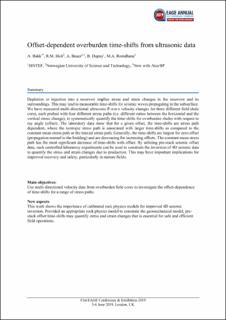Offset-Dependent Overburden Time-Shifts from Ultrasonic Data
Chapter
Accepted version

Åpne
Permanent lenke
https://hdl.handle.net/11250/2673905Utgivelsesdato
2019Metadata
Vis full innførselSamlinger
Originalversjon
10.3997/2214-4609.201900804Sammendrag
Depletion or injection into a reservoir implies stress and strain changes in the reservoir and its surroundings. This may lead to measurable time-shifts for seismic waves propagating in the subsurface. We have measured multidirectional ultrasonic P-wave velocity changes for three different field shale cores, each probed with four different stress paths (i.e. different ratios between the horizontal and the vertical stress change), to systematically quantify the time-shifts for overburden shales with respect to ray angle (offset). The laboratory data show that for a given offset, the time-shifts are stress path dependent, where the isotropic stress path is associated with larger time-shifts as compared to the constant mean stress path or the triaxial stress path. Generally, the time-shifts are largest for zero offset (propagation normal to the bedding) and are decreasing for increasing offsets. The constant mean stress path has the most significant decrease of time-shifts with offset. By utilizing pre-stack seismic offset data, such controlled laboratory experiments can be used to constrain the inversion of 4D seismic data to quantify the stress and strain changes due to production. This may have important implications for improved recovery and safety, particularly in mature fields.